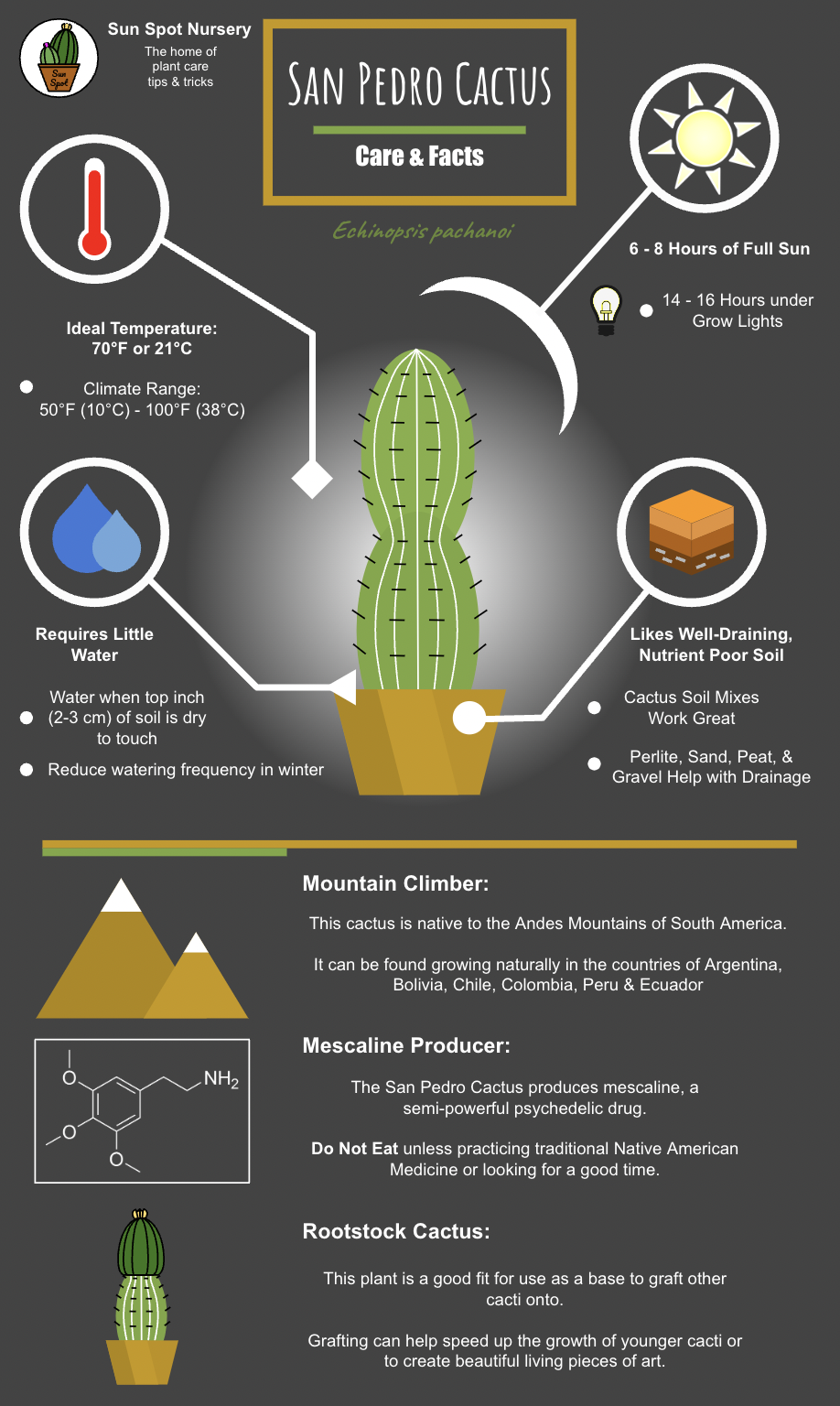The San Pedro cactus, scientifically known as Echinopsis pachanoi, is a remarkable species belonging to the family Cactaceae. Renowned for its psychoactive properties and striking appearance, the San Pedro cactus has captured the interest of both horticulturists and psychonauts alike. Identification of this cactus is crucial for enthusiasts and cultivators, as it helps in appropriate care and ensures the authenticity of the species. This article will delve into the distinctive characteristics of the San Pedro cactus, enabling accurate identification and understanding its unique features.
Recognizing the San Pedro Cactus Structure
The first step in identifying the San Pedro cactus involves examining its physical structure. This species typically exhibits a columnar shape, growing upright in a manner that can reach impressive heights of up to 20 feet in its native habitat. The plant’s stem comprises several distinct ribs, typically ranging from 4 to 8 per column. These ribs are pivotal for a keen observer, as they contribute to the cactus’s overall appearance. The stem is often vividly green, a hue that varies depending on sunlight exposure and the age of the cactus. Notably, an adult San Pedro cactus can grow considerable arms, although younger specimens usually present as single columns.
Observing the Spine Arrangement
Another vital attribute for identifying the San Pedro cactus is its spine arrangement. The spines are generally short and can appear in various colors, most notably white or yellow. Each areole, which is a small rounded structure from which spines grow, typically harbors one or two prominent central spines and several radial spines. The central spines can measure between 1 to 5 inches long, while the radial spines are much shorter, lending a distinct texture to the cactus. Unlike some other cacti that boast a dense spine cover, the San Pedro’s spines are relatively sparse, making it less daunting to handle. Caution is advised, as the spines can still prick, albeit not as aggressively as those found on other cacti.
A Detailed Look at the Flowering Phenomenon
The San Pedro cactus is not only visually striking because of its size and shape but also due to its flamboyant flowers. When conditions are optimal, typically during the warmer months, this cactus produces funnel-shaped flowers that are a sight to behold. The flowers often bloom at night, emitting a delightful fragrance that attracts a variety of pollinators. These flowers are typically white or pale yellow and can reach lengths of up to 6 inches, appearing in a crown around the top of the cactus limbs. A well-cared-for San Pedro not only beautifies your landscape but also adds a palatial aura when in bloom.
Understanding Growth Patterns and Habitat
The growing conditions significantly influence the San Pedro cactus’s morphology. In its native Andes mountain range, it thrives in altitudes ranging from 3,000 to 4,000 meters, demonstrating a threshold for temperature and light exposure. Proper identification can thus extend to environmental comprehension—recognizing that the San Pedro cactus flourishes in well-draining soil and requires ample sunlight. In cultivation, it is crucial to mimic these conditions. Cactophiles should aim for a sandy or loamy substrate to prevent water retention, thereby avoiding root rot. This understanding helps identify what an ideal growing San Pedro should reflect in its health and vigor.
Distinguishing Features of Varieties
While the Echinopsis pachanoi is the primary variety people encounter, it is essential to note that there are several other varieties and species within the same genus. Variants like the Echinopsis peruviana and Echinopsis terscheckii resemble the San Pedro cactus but may have differing features such as spine density, coloration, and growth habits. Identifying the exact characteristics of the San Pedro versus its close relatives is critical for horticultural purposes. Some may mistake the San Pedro cactus for other columnar cactus species due to similarities in shape and size. A deeper understanding of the subtle nuances in appearance is required, focusing on rib count, spine morphology, and flowering patterns to avoid confusion.
Addressing Buyer Concerns About Authenticity
When purchasing a San Pedro cactus, authenticity is a significant concern for many buyers. With the rise of interest in psychedelics, the market has seen an influx of imitations and hybrids that may not possess the same properties as the true San Pedro. Buyers should seek reputable dealers who can provide complete information on their plants’ origins and specific species. Examining the plant in person prior to purchase can further ensure that you are acquiring a genuine Echinopsis pachanoi. It is prudent to familiarize yourself with the distinctive features discussed previously so that you can make an informed decision.
Caring for Your San Pedro Cactus
After successfully identifying a San Pedro cactus, understanding its care requirements is essential for fostering healthy growth. This cactus requires minimal watering during dormant periods while benefiting from supplemental watering during active growth seasons. The use of cactus-specific fertilizers can also enhance growth rates and flowering potential. Awareness of common diseases and pests is equally vital to maintain your San Pedro’s health and aesthetic appeal.
In summary, recognizing and properly identifying the San Pedro cactus entails a comprehensive examination of its structure, flowering characteristics, growth conditions, and differentiation from similar species. This considerable understanding not only provides valuable insights for cultivation but also enriches the overall experience of engaging with this captivating plant. As the interest in the San Pedro cactus continues to evolve, possessing knowledge of its unique traits will infinitely enhance your dealings with this extraordinary species.





Leave a Comment